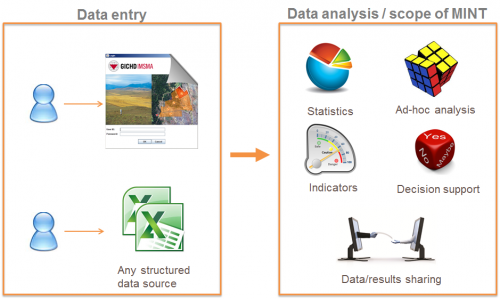Difference between revisions of "Portal:Business Intelligence/Introduction"
| Line 1: | Line 1: | ||
| − | Business intelligence (BI) is a set of theories, methodologies, architectures, and technologies that transform raw data into meaningful and useful information<ref>http://en.wikipedia.org/wiki/Business_intelligence</ref>. While operational systems - such as {{IMSMANG}} and many others - are designed and optimised for data entry | + | Business intelligence (BI) is a set of theories, methodologies, architectures, and technologies that transform raw data into meaningful and useful information<ref>http://en.wikipedia.org/wiki/Business_intelligence</ref>. While operational systems - such as {{IMSMANG}} and many others - are designed and optimised for data entry and updates, a BI system is read-only and designed for '''analysing''' and '''visualising''' data. The overall objective is to inform the decision making process, thus allow for evidence-based decision making. An important criterion of the underlying data is its '''quality''' - meaningful analysis can only be achieved if the input data is accurate, complete, and of known quality. |
| − | The Mine Action INTelligence Tool (MINT -- the name is a reference to Business Intelligence) has been introduced to allow | + | The Mine Action INTelligence Tool (MINT -- the name is a reference to Business Intelligence) has been introduced to facilitate the reporting process, and allow for analysis and visualisation of mine action data from {{IMSMANG}} and/or other sources. It is a tool and service provided by the GICHD to the wider mine action community. |
Use cases for MINT include: | Use cases for MINT include: | ||
| − | * Creating digital dashboards to convey | + | * Creating digital dashboards to convey key information to specific audiences |
| − | * Tracking indicators and progress | + | * Tracking indicators and progress |
* Creating interactive reports | * Creating interactive reports | ||
* Scheduling reports and sending notifications -- for example, send a specific report as a PDF attachment by email every Monday at 08:00 to the operations manager | * Scheduling reports and sending notifications -- for example, send a specific report as a PDF attachment by email every Monday at 08:00 to the operations manager | ||
Revision as of 15:30, 26 January 2015
Business intelligence (BI) is a set of theories, methodologies, architectures, and technologies that transform raw data into meaningful and useful information[1]. While operational systems - such as IMSMANG and many others - are designed and optimised for data entry and updates, a BI system is read-only and designed for analysing and visualising data. The overall objective is to inform the decision making process, thus allow for evidence-based decision making. An important criterion of the underlying data is its quality - meaningful analysis can only be achieved if the input data is accurate, complete, and of known quality.
The Mine Action INTelligence Tool (MINT -- the name is a reference to Business Intelligence) has been introduced to facilitate the reporting process, and allow for analysis and visualisation of mine action data from IMSMANG and/or other sources. It is a tool and service provided by the GICHD to the wider mine action community.
Use cases for MINT include:
- Creating digital dashboards to convey key information to specific audiences
- Tracking indicators and progress
- Creating interactive reports
- Scheduling reports and sending notifications -- for example, send a specific report as a PDF attachment by email every Monday at 08:00 to the operations manager
- Performing ad-hoc data analyses by dragging and dropping fields from predefined data sources
More details and a list of all features are available on the main MINT page.
